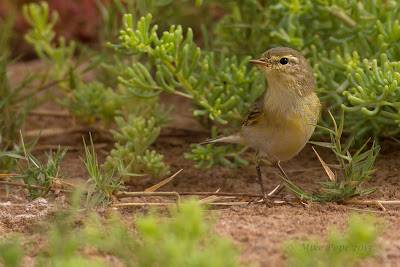I had a productive morning at Jahra Pools and am always amazed at the bird movement during migration - no two days are the same!
As it was the Pools, passerines were outnumbered by waterbirds and waders, but there was still good variety to be enjoyed by Khaled Al Ghanem and I.
This week Common Ringed Plovers had replaced Little Ringed Plovers that were seen in the previous week.
 |
| Displaying Common Ringed Plover (Charadrius hiaticula) |
The Kentish Plover adults were not as vigilant over their now grown chicks which were almost independent
 |
| Male Kentish Plover (Charadrius alexandrinus) |
 |
| Curlew Sandpiper (Calidris ferruginea) |
 |
| Breeding plumage Temminck's Stint (Calidris temminckii) |
 |
| Non-breeding plumage Temminck's Stint (Calidris temminckii) |
 |
| Adult Little Stint (Calidris minuta) |
 |
| Male Little Bittern (Ixobrychus minutus) |
 |
| Little Egret (Egretta garzetta) |
 |
| Male and Female Ferruginous Duck (Aythya nyroca) |
 |
| Female Mallard (Anas platyrhynchos) with her ducklings |
 |
| Female Tufted Duck (Aythya fuligula) |
 |
| Red-backed Shrike (Lanius collurio) |
 |
| Male Red-backed Shrike (Lanius collurio) |
 |
| Common Whitethroat (Sylvia communis) |
Sedge Wablers were heard and seen along the reed base
 |
| Sedge Warbler (Acrocephalus schoenobaenus) |
 |
| Upcher's Warbler (Hippolais languida) |
The Willow Warblers are found in and around the reed beds and many of this little birds fall victim to the Red-backed Shrikes
 |
| Willow Warbler (Phylloscopus trochilus) |
 |
| Spotted Flycatcher (Muscicapa striata) |
 |
| Turkestan Shrike (Lanius phoenicuroides) |
 |
| Turkestan Shrike (Lanius p. karelini) |
 |
| Male Ortolan Bunting (Emberiza hortulana) |
 |
| Arabian Red Fox (Vulpes vulpes arabica) pup |
Jahra Pools is really a great reserve and should continue to be so on condition the water supply is maintained. I believe we will get many more good breeding records and rarities before this year ends.




No comments:
Post a Comment